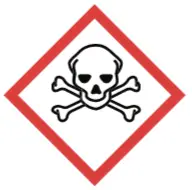Objective
To perform an electrophilic addition of a carbene to an alkene in order to allow the simultaneous formation of two C−C bonds, producing a cyclopropane derivative.
![synthesis of carbenes: preparation of 7,7-dichlorobicyclo[4.1.0]heptane](https://www.chemistry-online.com/wp-content/uploads/2023/01/sch-carbenes.png)
Background
Electrophilic additions to the double bonds are one of the most common transformations in an Organic Chemistry laboratory. They are also among the most powerful reactions in Organic Chemistry. Using this type of reaction, a relatively simple compound can represent a large amount of molecular complexity in one step. Many carbenes are electrophilic and and are able to be added to alkenes. Most carbenes (R2C:) are prepared by a α-elimination, where the electrophilic and nucleophilic groups are from the same carbon atom. Generally, it is a base-catalyzed elimination.
Experimental procedure
To a 50 ml Erlenmeyer, add 2 g (0.05 moles) of NaOH and 2 ml of water. Close the flask with a stopper and shake to dissolve the base. A strong exotherm reaction is observed, so the solution must be cooled using an external ice bath until room temperature is reached. Then add 0.4 g (0.001 mol) tricaprylmethyl ammonium chloride (Aliquat 336®), 2 ml (1.62 g, 0.02 moles) of cyclohexene and 2 ml (2.98 g, 0.025 moles) of chloroform, and stopper again. Shake the mixture vigorously for 20 min, ensuring that an emulsion is formed.
At the end of the reaction time, transfer the oil to a separatory funnel with the aid of an additional 15-20 ml water. Drag the contents of the flask with 5 ml CH2Cl2. Stir the mixture and decant. Repeat with another 5 ml of CH2Cl2.
Collect and dry the organic phase with anhydrous sodium sulfate Na2SO4. Filter (solid disposable), and transfer the filtrate to a tared flask. Remove the solvent together with the remains of cyclohexene and any remaining chloroform on a rotary evaporator. A liquid is the final product.
Physico-chemical properties
This table collects data for the molecular weight (Mw), melting point (M.p.) boiling point (B.p.) and density of the reactives and compounds used in this laboratory experiment.
| Name | Mw (g/mol) | M.p. (ºC) | B.p. (ºC) | Density (g/ml) |
| Aliquat® 336 | - | -6 | - | - |
| Cyclohexene | 82.14 | -104 | 83 | 0.779 |
| CH2Cl2 | 84.93 | -97 | 40.0 | 1.33 |
GHS pictograms
Hazard pictograms form part of the international Globally Harmonized System of Classification and Labelling of Chemicals (GHS) and are collected in the followinf Table for the chemical compounds used in this experiment.
| Name | GHS |
| Aliquat® 336 |    |
| Cyclohexene |    |
| CH2Cl2 |  |
International Chemical Identifier
The IUPAC InChI key identifiers for the main compounds used in this experiment are provided to facilitate the nomenclature and formulation of chemical compounds and the search for information on the Internet for these compounds.
| Aliquat® 336 | |
| Cyclohexene | HGCIXCUEYOPUTN-UHFFFAOYSA-N |
| CH2Cl2 | YMWUJEATGCHHMB-UHFFFAOYSA-N |
References
- Isac-García, J.; Dobado, J. A.; Calvo-Flores, F. G.; and Martínez-García, H. (2015). Experimental Organic Chemistry Laboratory Manual. Elsevier Science & Technology. ISBN: 978-0-12-803893-2
- A. Ault and B. Wright, 2,2-Dichlorobicyclo[4.1.0]heptane from cyclohexene and dichloro- carbene by phase transfer catalysis, Journal of Chemical Education 53 (1976), no. 8, 489, DOI: 10.1021/ed053p489